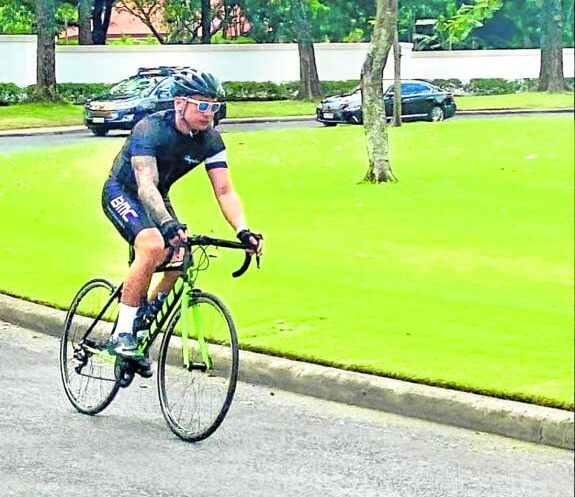Coming soon: Road map for active transport

Advocacy groups are reminding motorists not to use bike lanes. —PHOTO BY JOEL MACAWILE/CONTRIBUTOR
(Conclusion)
Biking as an alternative form of mobility is seen as the sustainable choice as it emits no smoke, unlike the vehicles that rule the roads.
“To the extent that these alternative green alternatives to transport can lower dependence on energy and corresponding demand, then yes, it has helped [in lowering transport costs],” ING Bank economist Nicholas Mapa says.
But more needs to be done to increase adoption of active transport in the country.
“We could see a more pronounced shift if government aids the shift to green mobility,” the economist concludes.
Motorist behavior
To improve road safety, Ira Cruz, director of transport group AltMobility PH, says motorists securing a driver’s license should be educated about the rules of the road pertaining to bike lane use.
There have been reports about motor vehicles using the cycleways. This is among the hazards faced by bikers as it can cause accidents. Data from the World Health Organization show that 12,000 Filipinos die on the road each year.
Eldon Dionisio, Department of Transportation Active Transport Program manager, notes that attached agencies Land Transportation Office (LTO) and Land Transportation Franchising and Regulatory Board released guidelines on how to properly utilize the road for cyclists and motorized vehicle drivers.
Such guidelines are also reflected on the theoretical driving courses of the LTO, he adds.
Transportation Secretary Jaime Bautista has recently launched the Philippine Road Safety Action Plan, which also promotes road safety education.
Bike sharing program
Robert Siy, co-convener of transport advocacy group Move as One Coalition, says that bike rental and sharing services must be made available in every community, especially in tourist destinations. These can support the shift to active transport, he points out.
Cruz agrees that bike sharing programs will entice even individuals without bikes to try them out and experience how to navigate the roads.
The AltMobility director stresses that should this be pursued, the system must enable bikers to traverse city to city using the same bike for seamless connectivity.
“However, in order for it to make sense, it has to understand the behavior of the Metro Manila residents. People work and live in different cities,” he explains.
The Department of Transportation (DOTr) is planning to put up an automated bike sharing program, Dionisio shares. He says the goal is to create a mobile platform where users can reserve a bike. It will also be designed to provide information about bike availability and locations of stations where the bikes can be returned.
The initial plan includes establishing stations at “fundamental facilities, including public transport, medical, academic, major commercial establishments and major government offices,” Dionisio enumerates.
He says that the bikes can be used along the Edsa corridor—Metro Manila’s busiest thoroughfare—which links multiple cities.
Traffic counters, policy development
Dionisio notes there is still a lack of data when it comes to active transport in the country. But he stresses the government is making moves to resolve this.
For one, the DOTr is targeting to install traffic counters along existing key bike lanes, including those along Edsa, C5 and other major thoroughfares.
“This year, part of our program is the procurement and installation of what we call traffic counters. But it will not count motor vehicles; it will count cyclists and pedestrians,” he says.
Dionisio shares that the department wants to purchase standalone counters equipped with sensors that can detect the number of cyclists and pedestrians. Those data are crucial in crafting better policies, he points out. For example, if a bike lane sees only few bikers and pedestrians, it could mean the public is avoiding it due to poor infrastructure, allowing the DOTr to address the problem immediately, he says.
The DOTr hopes to install these traffic counters by August or September.
Road map paved with bike lanes
The Transportation department is working on developing an active transport infrastructure master plan and feasibility study to provide direction on the implementation of related projects, policies and programs, Dionisio says.
He explains the goal is to establish a road map on active transport for the next five to 10 years.
Pushing for this agenda is a way to offer another mode of transportation, especially in populated areas where heavy traffic flow is a typical headache among commuters.
“In order for our cities to work, we need to be able to make multiple forms of transportation available for everybody, which means that people should have a choice of a mode of transportation,” Cruz explains.
Read Next
Subscribe to INQUIRER PLUS to get access to The Philippine Daily Inquirer & other 70+ titles, share up to 5 gadgets, listen to the news, download as early as 4am & share articles on social media. Call 896 6000.
For all the latest Business News Click Here
For the latest news and updates, follow us on Google News.



